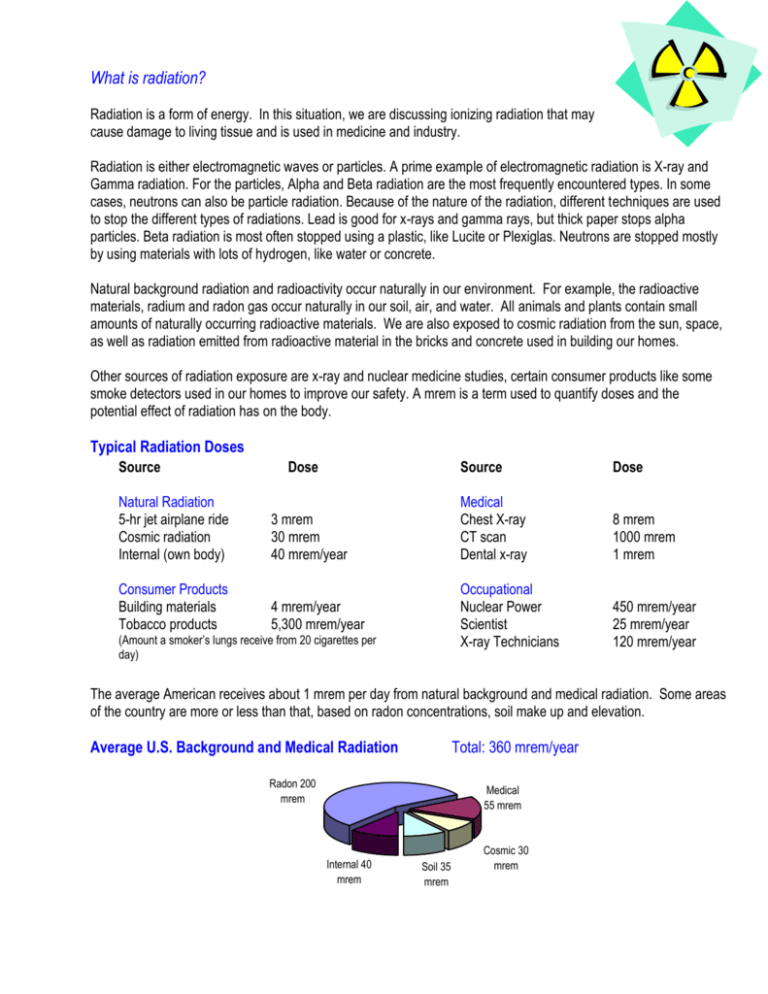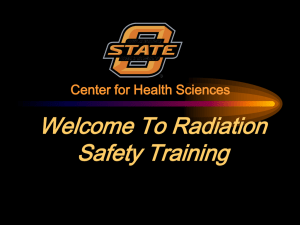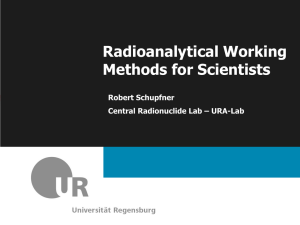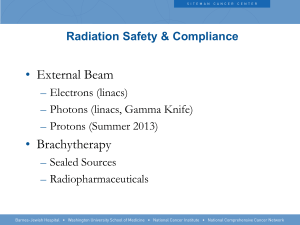Radiation and You - Outline - Middle School Presentation
advertisement

What is radiation? Radiation is a form of energy. In this situation, we are discussing ionizing radiation that may cause damage to living tissue and is used in medicine and industry. Radiation is either electromagnetic waves or particles. A prime example of electromagnetic radiation is X-ray and Gamma radiation. For the particles, Alpha and Beta radiation are the most frequently encountered types. In some cases, neutrons can also be particle radiation. Because of the nature of the radiation, different techniques are used to stop the different types of radiations. Lead is good for x-rays and gamma rays, but thick paper stops alpha particles. Beta radiation is most often stopped using a plastic, like Lucite or Plexiglas. Neutrons are stopped mostly by using materials with lots of hydrogen, like water or concrete. Natural background radiation and radioactivity occur naturally in our environment. For example, the radioactive materials, radium and radon gas occur naturally in our soil, air, and water. All animals and plants contain small amounts of naturally occurring radioactive materials. We are also exposed to cosmic radiation from the sun, space, as well as radiation emitted from radioactive material in the bricks and concrete used in building our homes. Other sources of radiation exposure are x-ray and nuclear medicine studies, certain consumer products like some smoke detectors used in our homes to improve our safety. A mrem is a term used to quantify doses and the potential effect of radiation has on the body. Typical Radiation Doses Source Dose Natural Radiation 5-hr jet airplane ride Cosmic radiation Internal (own body) 3 mrem 30 mrem 40 mrem/year Consumer Products Building materials Tobacco products 4 mrem/year 5,300 mrem/year (Amount a smoker’s lungs receive from 20 cigarettes per day) Source Dose Medical Chest X-ray CT scan Dental x-ray 8 mrem 1000 mrem 1 mrem Occupational Nuclear Power Scientist X-ray Technicians 450 mrem/year 25 mrem/year 120 mrem/year The average American receives about 1 mrem per day from natural background and medical radiation. Some areas of the country are more or less than that, based on radon concentrations, soil make up and elevation. Average U.S. Background and Medical Radiation Total: 360 mrem/year Radon 200 mrem Medical 55 mrem Internal 40 mrem Soil 35 mrem Cosmic 30 mrem Are there limits for radiation exposure? A person who works with radiation as part of their job can legally receive 5,000 mrem/year. A facility cannot expose the general public to more than 100 mrem/year. On a tour of our facility, you will not receive any radiation exposure above background. Workers protect themselves from radiation using three main methods: Time, Distance and Shielding. Whenever possible, we will reduce time we are exposed to a radiation field, increase our distance from source and use shielding between the source and us. Shielding is dependent on the radiation itself, as shown below. Glossary Radiation: Radiation cannot be seen, felt or heard. It comes in waveform, like light and in particulate form (very small particles), like electrons. Radioactive Material: Any material that contains radioactive atoms. For example, when you get a nuclear medicine scan, you are injected with radioactive material. Radiation Absorbed Dose (RAD): The RAD is a unit used to measure the amount of energy absorbed in any material such as concrete, steel, bone, lead, and tissue. Roentgen Equivalent Man (REM): The REM relates the RAD to the biological impact caused by different types of radiation. It is a term used to quantify does and the potential effect a does of radiation has on the body. In most cases the rem is that same value as the rad. A millirem (mrem) is 1/1,000th of a rem. Curie (Ci): The curie is a unit to measure radioactivity much as we would measure water in gallons, quarts, or ounces. The amount of radioactive material given to a patient is usually in millicuries (mCi). A mCi is 1/1000th of a curie. For more information on radiation, see the Radiation Information Network at http://www.physics.isu.edu/radinf/index.html Examples of Applications of Radiation Medical: Diagnostic X-rays (dental X-rays, CAT scans, mammograms, etc). Therapeutic (Co-60, accelerators for cancer treatments). Diagnostic nuclear medicine (liver function tests). Therapeutic nuclear medicine (1-131 for thyroid cancer treatment). Nuclear thermoelectric-powered heart pacemakers. Blood irradiation Research: X-ray diffraction (study of molecular structure - e.g. DNA structure). Isotopic tracers (e.g. C-14 to study photosynthesis). Isotopic labeling (e.g. P-32 DNA electrophoresis) Accelerators (nuclear structure, materials analysis). Electron microscopes. Consumer Products: Cathode ray tubes (TVs) Smoke detectors. Emergency lighting. Static eliminators. Luggage screening systems. (X-ray). Industrial: Sterilization (of medical materials & supplies). Insect eradication (release of insects sterilized by irradiation). Food preservation. Process control (density/Thickness gauges). “Curing” of plastics. Asphalt density Moisture content for soil Industrial radiography (verification of welds & structures). Ion implantation (semiconductor industry). Electron beam applications (e.g. vacuum deposition) National Defense: Nuclear weapons. Strategic defense (X-ray lasers, particle beams, etc.) Power: Nuclear Fission Reactors for electricity (~20% of US electricity). Nuclear Fission Reactors on Navy ships and submarines. Nuclear Fusion (future use). Isotopic electric power sources (satellites, spacecraft). Visiting labs that use radioactive materials or radioisotopes. Important things to keep your eye out for: 1) 2) 3) 4) 5) 6) How do people protect themselves from the radiation? Why are they using the radioisotopes? How is the radioisotopes controlled? How are the labs that use radioisotopes posted (labeled)? How are the radioisotopes labeled? What other uses of radiation do you see? How a Geiger counter (Geiger Mueller detector) works GM Instrument Incident Ionizing Radiation Ne +Halogen Cathode - Gas + + + - + - Anode + - Electrical Current Measuring Device Voltage Source + The most common type of instrument is a gas filled radiation detector. This instrument works on the principle that as radiation passes through air or a specific gas, ionization of the molecules in the air occur. Ionization means that the radiation gives up some energy to the surrounding atoms, causing those atoms to loose their electrons. This results in ionized atoms (positive charged) and free electrons (negative charge). When a high voltage is placed between two areas of the gas filled space, the positive ions will be attracted to the negative side of the detector (the cathode) and the free electrons will travel to the positive side (the anode). In a GM tube as shown above, the voltage difference is high, so that the ions gain energy as they move towards the anode and cathode, causing more ionization. The whole tube will ionize, causing a large amount of charge at one time. The charge is collected by the anode and cathode as a pulse of current in the wires going to the detector. By placing a very sensitive measuring device along that wire, the pulse measured and displayed as a count. The more radiation which enters the chamber, the more count are seen by the instrument.








